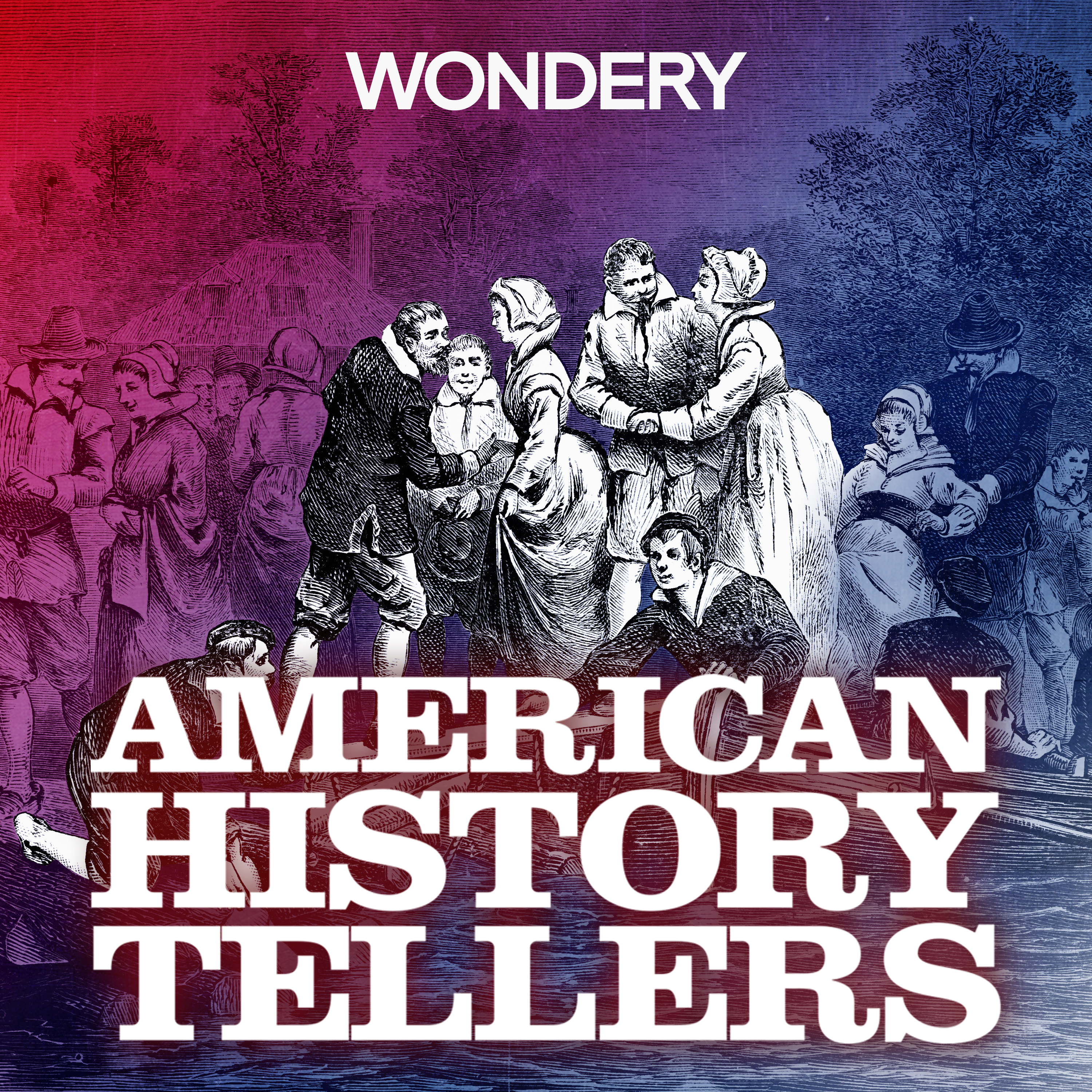Episodes
Published 12/04/24
In October 1860, railroad engineer Theodore Judah looked out across California’s Sierra Nevada range, dreaming of a railroad that would connect the United States from coast to coast. It was the start of a decade-long endeavor to build the world’s first transcontinental railroad.
Two competing railroad companies would eventually begin construction, but laying nearly 2,000 miles of iron track across America’s expanse would require vast sums of money – and unimaginable feats of...
Published 11/13/24
Published 11/12/24
Many people are familiar with Powhatan, the Paramount Chief who ruled over a vast network of more than 30 tribes in the Chesapeake region when the English arrived in 1607. But it was Powhatan’s brother, Opechancanough, who came closest to wiping out the English colony at Jamestown. Today, Lindsay is joined by Dr. James Horn, President of the Jamestown Rediscovery Foundation. He’s the author of A Brave and Cunning Prince: The Great Chief Opechancanough and the War for America.
Order your copy...
Published 11/06/24
In April 1613, years of bloody warfare culminated in the kidnapping of the paramount chief Powhatan’s daughter Pocahontas. The English colonists in Jamestown offered to return her in exchange for stolen weapons, English prisoners, and corn, but their proposal was met with silence.
In the meantime, Pocahontas befriended English colonist John Rolfe. Rolfe poured his energy into cultivating a tobacco crop suitable for export, starting a tobacco revolution that would change Virginia...
Published 10/30/24
Published 10/29/24
In the summer of 1609, a hurricane struck a large English fleet bound for Virginia on a rescue mission. Some of the battered survivors safely landed in Jamestown, but the flagship Sea Venture and the provisions it carried were lost. The already hungry colonists were forced to face the winter without those much-needed supplies.
That fall, Powhatan Indians laid siege to Jamestown. Roughly 300 colonists were trapped inside the fort, with no ability to hunt or forage. As food supplies dwindled,...
Published 10/23/24
In January 1608, fire blazed through the English settlement in Jamestown, Virginia. Nearly every building was reduced to ash. The destruction meant that the colonists would have to brave the winter with nothing but the clothes on their backs. More than ever before, their survival depended on the goodwill of the paramount chief Powhatan.
As the colony’s leaders desperately searched for gold, mistrust grew between Powhatan and the European newcomers. Hunger and division in Jamestown worsened,...
Published 10/16/24
Published 10/15/24
October 14, 1947. US Air Force Captain Chuck Yeager becomes the first person to fly faster than the speed of sound, a feat many aviators previously believed impossible.
You can listen ad-free in the Wondery or Amazon Music app. Or for all that and more, go to IntoHistory.com
History Daily is a co-production of Airship and Noiser.
Go to HistoryDaily.com for more history, daily.
See Privacy Policy at https://art19.com/privacy and California Privacy Notice at...
Published 10/14/24
In December 1606, three ships carrying 104 settlers left England and set sail for Virginia’s Chesapeake Bay. Six months later, they arrived on a narrow peninsula in the James River and founded Jamestown, the first permanent English settlement in mainland North America.
From the start, faction and infighting threatened to tear the colony apart. And soon, the colonists’ pursuit of gold and glory would put them on a collision course with Virginia’s native inhabitants and their ruler, the...
Published 10/09/24
After the RMS Titanic sank in 1912, the ocean liner's fame only continued to grow. Today, Lindsay is joined by journalist Daniel Stone to discuss how generations of people searched for the sunken Titanic, the holy grail of wrecks. He charts the ship’s fandom, from mere enthusiasts to an obsessive who claimed ownership of the vessel. Daniel Stone is the author of Sinkable: Obsession, the Deep Sea, and the Shipwreck of the Titanic.
Order your copy of the new American History Tellers book, The...
Published 10/02/24
September 30, 1520. Suleiman the Magnificent becomes Sultan of the Ottoman Empire, and sets his sights on conquering Europe.
You can listen ad-free in the Wondery or Amazon Music app. Or for all that and more, go to IntoHistory.com
History Daily is a co-production of Airship and Noiser.
Go to HistoryDaily.com for more history, daily.
See Privacy Policy at https://art19.com/privacy and California Privacy Notice at https://art19.com/privacy#do-not-sell-my-info.
Published 09/30/24
On April 16, 1912, shocked survivors of the Titanic made their way to New York aboard the rescue ship, RMS Carpathia, and news of the tragedy began to spread around the world. Congress and the British Board of Trade both launched investigations into maritime safety regulations, seeking justice for the 1,500 victims of the disaster.
As years went by, the public’s fascination with the event only grew, and explorers began to search for the wreckage of the Titanic, hoping to solve its most...
Published 09/25/24
Published 09/23/24
Just past midnight on April 15th, 1912, only 20 minutes after striking an iceberg, the Titanic began taking on water in her forward hull. Captain Edward Smith quickly realized the ship was doomed to sink and issued orders to start loading the lifeboats. But with only 20 lifeboats on board, more than half the 2,200 passengers and crew would be left behind. As the severity of the disaster spread among the passengers, they would be forced to make terrifying decisions.
Order your copy of the...
Published 09/18/24
September 16, 1920. A horse-drawn wagon explodes in the middle of New York’s financial district, killing 30 people.
You can listen ad-free in the Wondery or Amazon Music app. Or for all that and more, go to IntoHistory.com.
History Daily is a co-production of Airship and Noiser.
Go to HistoryDaily.com for more history, daily.
See Privacy Policy at https://art19.com/privacy and California Privacy Notice at https://art19.com/privacy#do-not-sell-my-info.
Published 09/16/24
When the RMS Titanic launched in April of 1912, it was the pinnacle of luxury and the largest vessel to ever set sail. It was also an engineering marvel, as sophisticated as the most elegant hotels, and deemed incapable of sinking. But on its maiden voyage, in the frigid waters of the North Atlantic, the Titanic collided with a massive iceberg. Within minutes, the ship began to take on water, and the unthinkable began: the start of a shocking and tragic maritime disaster.
Order your copy...
Published 09/11/24
Published 09/10/24
In 1981, a gunman fired six shots at Ronald Reagan after the president gave a speech at a Washington D.C. hotel. Over the next several hours, split-second decisions made by Secret Service agents and D.C. hospital staff would determine whether Reagan would live or die. Amidst Cold War tensions, as Reagan lay unconscious in an operating room, questions would emerge over the presidential line of succession and who was actually running the government.
Order your copy of the new American...
Published 09/04/24
September 2nd 1666: the Great Fire of London begins in a bakery on Pudding Lane, before quickly spreading and reducing one third of London to ashes. This episode originally aired in 2022.
Support the show! Join Into History for ad-free listening and more.
History Daily is a co-production of Airship and Noiser.
Go to HistoryDaily.com for more history, daily.
See Privacy Policy at https://art19.com/privacy and California Privacy Notice at https://art19.com/privacy#do-not-sell-my-info.
Published 09/02/24
On November 22, 1963, John F. Kennedy was shot and killed while riding in his presidential limo through downtown Dallas. His violent and public death became one of the most traumatic moments in the nation’s history — and one of the most controversial, as Americans debated the mystery around his killer, Lee Harvey Oswald. The tragedy also thrust Vice President Lyndon Johnson into the White House, where he battled Kennedy’s brother Bobby for control of JFK’s legacy, and passed landmark...
Published 08/28/24
In September 1901, President William McKinley visited the Pan-American Exposition in Buffalo, New York to deliver a speech celebrating American achievements at home and abroad. But waiting in the crowd in Buffalo was an embittered Polish-American laborer seeking to prove his commitment to the anarchist cause. Leon Czolgosz fired two bullets, striking the 25th president and sparking a rush to save McKinley’s life. With the president’s life hanging in the balance, McKinley’s ambitious Vice...
Published 08/21/24
Description: August 19, 1991. A group of Communist Party hardliners attempt to save the collapsing Soviet Union by staging a coup against party leader, Mikhail Gorbachev. This episode originally aired in 2022.
You can listen ad-free in the Wondery or Amazon Music app. Or for all that and more, go to IntoHistory.com
History Daily is a co-production of Airship and Noiser.
Go to HistoryDaily.com for more history, daily.
See Privacy Policy at https://art19.com/privacy and California...
Published 08/19/24
On April 14th, 1865, John Wilkes Booth shot President Abraham Lincoln at Ford’s Theatre in Washington, D.C. Lincoln died hours later, shocking the war-torn nation and becoming the first President to be assassinated in office. But he would not be the last.
Sixteen years later, no action had been taken to protect the commander-in-chief. When James Garfield became president in March 1881, a disturbed and delusional former lawyer demanded a position in the new administration. Furious over his...
Published 08/14/24


